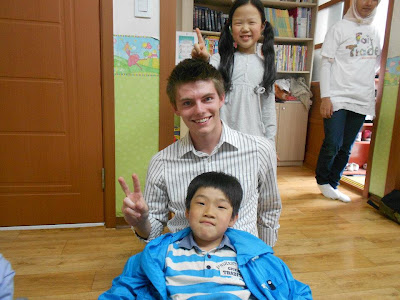Yesterday we visited the demilitarized zone, also known as the DMZ, which is a 4 km wide region between North and South Korea that runs from the west coast of the Korean peninsula all the way to the eastern coast. It was a very informative and interesting tour that consisted of three different stops.
The first stop was at Dorasan train station, which is located within the DMZ. This station is the only station with a track that runs from South Korea to North Korea, and more specifically to the capital of North Korea, Pyeongyang. It was built in an attempt to reunify the north and the south. Unfortunately, North Korea decided to change their minds midway through the process, so the tracks were never finished in North Korea and trains no longer run between the two countries. The station itself was very elegant and modern inside and seemed to have a promising future if the project would have been finished. Seeing as it wasn't, the station had a sort of eery feeling to me because it was such a beautiful station that appeared completely abandoned. Furthermore, the station showed me that south and north Koreans truly do want to reunite again, but that the North Korean government doesn't seem to be willing or ready to do so just yet. I say that it seems to be the North Korean government, because it was the South Korean government who was willing to pay for and build the entire track, including those in North Korea in order to bring the two countries together, but despite such generosity, the North Korean government still refused the idea.
The second stop on our tour was at the Dora Observatory, which is the northern most observatory in South Korea. From here, we were able to see the whole are between the two countries and into North Korea. It was interesting and sad to see how much less developed North Korea is than South Korea. There weren't many people that I could see in North Korea except for a few soldiers and a field fold of workers all dressed in white.
Our third and final stop on the tour was at the 3rd tunnel that South Korea discovered North Korea trying to dig underground as a way to sneak their soldiers into South Korea. It was a little scary to know that the road leading up to the 3rd tunnel and the entire area surrounding the tunnel was covered in around 750,000 land mines which have been left there from the Korean war. The South Koreans have already removed over 1,500,000 land mines since the signing of the cease-fire agreement with North Korea, so knowing that there are still that many left in the are was shocking to say the least. Prior to going into the tunnel, there was a history exhibit that provided a general overview of the war and had a display of all of the attacks on South Korea by North Korea since the signing of the cease-fire agreement. There was also supposed to be a movie that described more about the Korean War, but the projector was unfortunately not working on the day of our trip. So, instead we went straight to our descent down to the tunnel, which was quite a work out. The tunnel that we had to walk down to get to the tunnel dug by the North Koreans was just about 350 meters long and at an angle of about 60 degrees. Once at the bottom, we had to hunch over to walk through the North-Korean tunnel, which had a height of just over 5 ft. for most of it. Throughout the tunnel there were still the holes that were drilled into the walls to place dynamite into, which was how the length of the tunnel was dug out. Overall, the tunnel was a cool experience and reminded me a lot of the caves in Tennessee that I went to as a child, but they also sent chills down my spine when I realized how disastrous it would have been if North Korea had succeeded in its plan, and even more so when I thought about how close they did get to succeeding.
After finishing this trip, I am surprised at how relaxed people in Seoul seem to be and how unconcerned they are about the possibility of North Korea attempting to do the same thing again. Although, I feel my surprise might be a little unwarranted because even though North Korea did get close, it was over 30 yrs ago that this tunnel was found and so it seems unlikely that North Korea is still attempting the same thing because if they were they would have gotten all the way through already. Not to mention, North Korea appears to have far more primitive weapons than South Korea and the U.S. also has a permanent military base established in South Korea just in case of an attack.
Prior to this experience I always thought of the U.S. as somewhat of a world police in the aspect that we try to negotiate peace between countries, so I feel that this trip has reinforced that feeling and shown me the importance of our attempts to maintain the peace between countries. Unfortunately, I think our presence in South Korea has also had negative effects as well. North Korea still seems to have a strong hatred for America as a result of our aiding South Korea during the Korean War, and it is because of this hatred that I believe North and South Korea have not been able to establish better relations since we still have a strong presence in South Korea.





